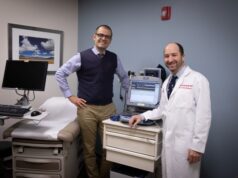Boston Scientific announced data from the AF-FICIENT I study during a late-breaking clinical trial session at the 2019 European Heart Rhythm Association annual congress (EHRA; 17–19 March, Lisbon, Portugal). The data demonstrated positive safety and efficacy results with the LUMINIZE radiofrequency (RF) balloon catheter for isolation of pulmonary veins (PV) when treating patients with atrial fibrillation (AF).
Patients with arrhythmias such as AF are often treated with anti-arrhythmic drugs as well as cardiac ablation. The LUMINIZE RF Balloon Catheter uses RF energy to isolate the areas of the heart muscle responsible for the abnormal heart rhythm. The single-shot catheter also features built-in digital cameras for visual guidance, sensing electrodes on the balloon to assess real-time vein isolation and customisable ablation electrodes with the ability to deliver tailored levels of energy around the circumference of the balloon.
The global AF-FICIENT I study examined acute procedural success and safety for the single-shot LUMINIZE RF balloon catheter in two phases. Phase one tested the original design of the device and phase two included changes to enhance manoeuverability and add dedicated pacing and sensing electrodes. Phase one study data showed PV isolation was achieved in 88.9% of veins. In phase two, with the enhanced steering capability and electrodes activated, PV isolation increased to 99.4% of veins. Additionally, the median time the balloon was in the left atrium decreased from 92 minutes in phase one to 29 minutes in phase two, bringing the total procedure time down to a median 71 minutes.
“The study assessed the safety and effectiveness of isolating PVs through the combined benefits of RF and balloon-based ablation, both of which are found in the LUMINIZE RF Balloon Catheter,” said Amin Al-Ahmad, principal investigator and cardiac electrophysiologist at Texas Cardiac Arrhythmia in Austin, USA. “The data underscore the potential for this catheter to improve procedural efficacy and patient outcomes.”
The prospective, non-randomised, multicentre study enrolled 100 patients with symptoms of paroxysmal AF. Confirmation of PV isolation was completed with the RF balloon sensing electrodes, a circular mapping catheter, or both. There were no device-related serious adverse events in either phase of the trial, 30 days after the completion of the procedures.
“We are pleased with the data presented today as it highlights the potential benefits of the LUMINIZE RF Balloon Catheter,” said Kenneth Stein, senior vice president and chief medical officer, Rhythm Management and Global Health Policy, Boston Scientific. “By providing real-time visualisation both before and during ablation and individualised control of electrode energy levels, this technology may allow physicians to swiftly and accurately isolate veins and decrease procedure times.”
The LUMINZE RF Balloon Catheter and the cryoballoon platform are in development, pending CE mark and are not available for use or sale.












